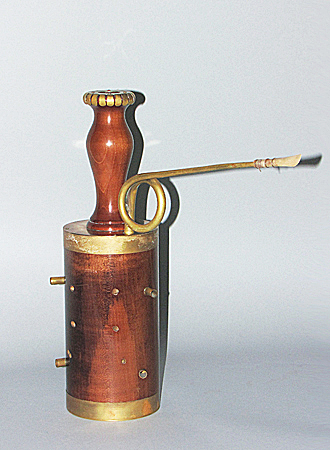
Owner: HWMC
Catalog # CL-AERV-69
Double Reed
Baroque 'Racket in C' - Moeck
Luckenweg, Germany
Moeck Musikinstrumente
Wood, metal, reed
ca. 1960’s
Height: 14.5 inches
Wind Instruments – Woodwinds – Double Reed
The racket (Fr. cervelas, Ger. rackett, rankett, or sausage bassoon) is a Renaissance double reed wind instrument, appearing late in the sixteenth century through the middle seventeenth century with the earliest account of the instrument from Michael Praetorius. He accounted for four sizes ranging from descant (soprano), tenor-alto, bass to great bass. The cylindrical structure was very compact with nine parallel cylindrical bores drilled lengthwise connecting alternate ends to form a continuous undulating tube inside.
The modified version is the baroque racket, developed in Nuremberg by Johann C. Denner (1655-1707). It appeared around 1700 and survived until around 1750. It has a wooden body and contains ten cylindrical bores increasing in size, with a coil brass crook inserted into the top to which the double reed is attached. A short pepper-pot bell joint is added to extend the sounding length, and there are ten finger holes, some containing a metal extension, played with the phalanges part of the hand. The Denner racket idea was taken up by makers in Germany, the Netherlands, and France.
During the mid 20th century a few reproductions were made as seen here. This is a Racket in C, Baroque type, made by Moeck, Luckenweg, Germany.
Resource: “Rachet.” William Waterhouse/R, “The Grove Dictionary of Musical Instruments.” 2nd ed. Vol. 4., Laurence Libin, Editor in Chief. Oxford University Press, 2014.
